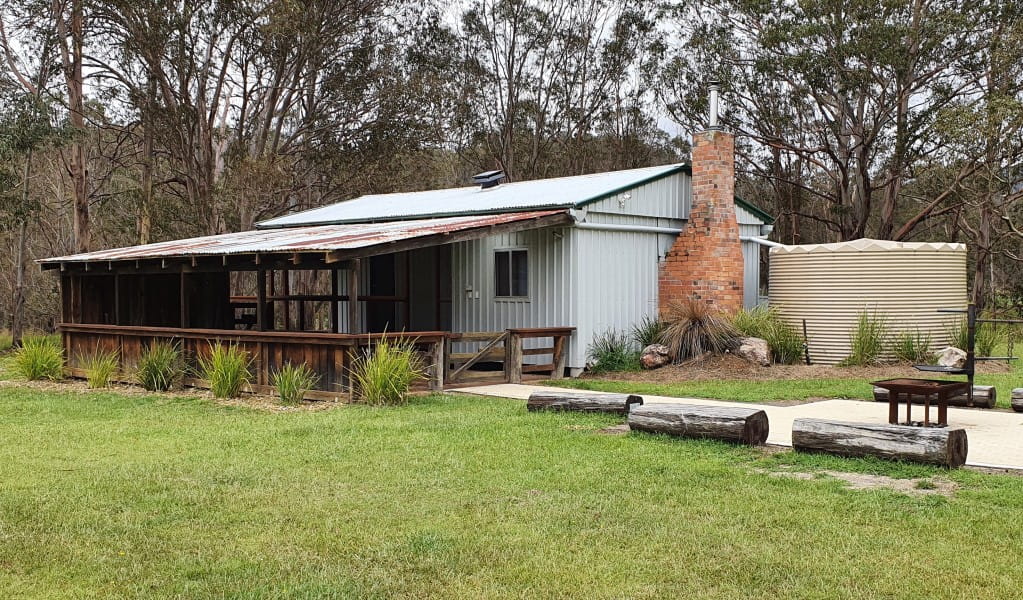Four Bull Hut
Washpool National Park
Overview
Stay in the rustic Four Bull Hut, tucked away in a secluded valley of Washpool National Park. This refurbished cabin the perfect escape for horse riding and other adventures, within driving distance of the NSW North Coast.
| Accommodation type | Cabin |
|---|---|
| Where | 461 Four Bull Trail, Forest Land, NSW, 2372 - in Washpool National Park |
| Bedrooms | 2 |
| Maximum guests | 6 |
| Facilities | Picnic tables, barbecue facilities, drinking water, showers, toilets, electric power, balcony, outdoor furniture, indoor fireplace, kitchen, plates and cutlery, pots and pans, rubbish bin |
| What to bring | Bed sheets, blankets, pillows, towels |
| Entry fees |
Park entry fees are not required to access Four Bull Hut |
| Please note |
|
Sleeping up to 6 guests, Four Bull Hut is surrounded by tall gum and Blackbutt forest offering endless walking, mountain biking, and bird watching opportunities, and secluded swimming spots in summer. You can also stay at this idyllic place with your horses as you explore the nearby network of Washpool horse riding trails. Only a few hours from Brisbane, it's great for couples or families wanting to enjoy nature in all its glory or seeking sanctuary from modern day distractions.
The rich heritage of Tenterfield’s early settlers can be seen only metres from your doorstep at historic McClifty’s Hut. Local lore tells of the hut’s first owner, Daniel McClifty, who shot four wild bulls at the creek when he first arrived.
Today, Four Bull Hut’s verandah is the ideal place to spot Washpool National Park’s wildlife, including red-necked wallabies, koalas, and black cockatoos. Keep your eyes peeled for the rare powerful owl and yellow-bellied glider.
Nearby
-

Washpool horse riding trails
Head to Washpool National Park for your next horse riding adventure. You’ll find 100km of great forest trails for all riding levels, a short drive from Tenterfield.
Map
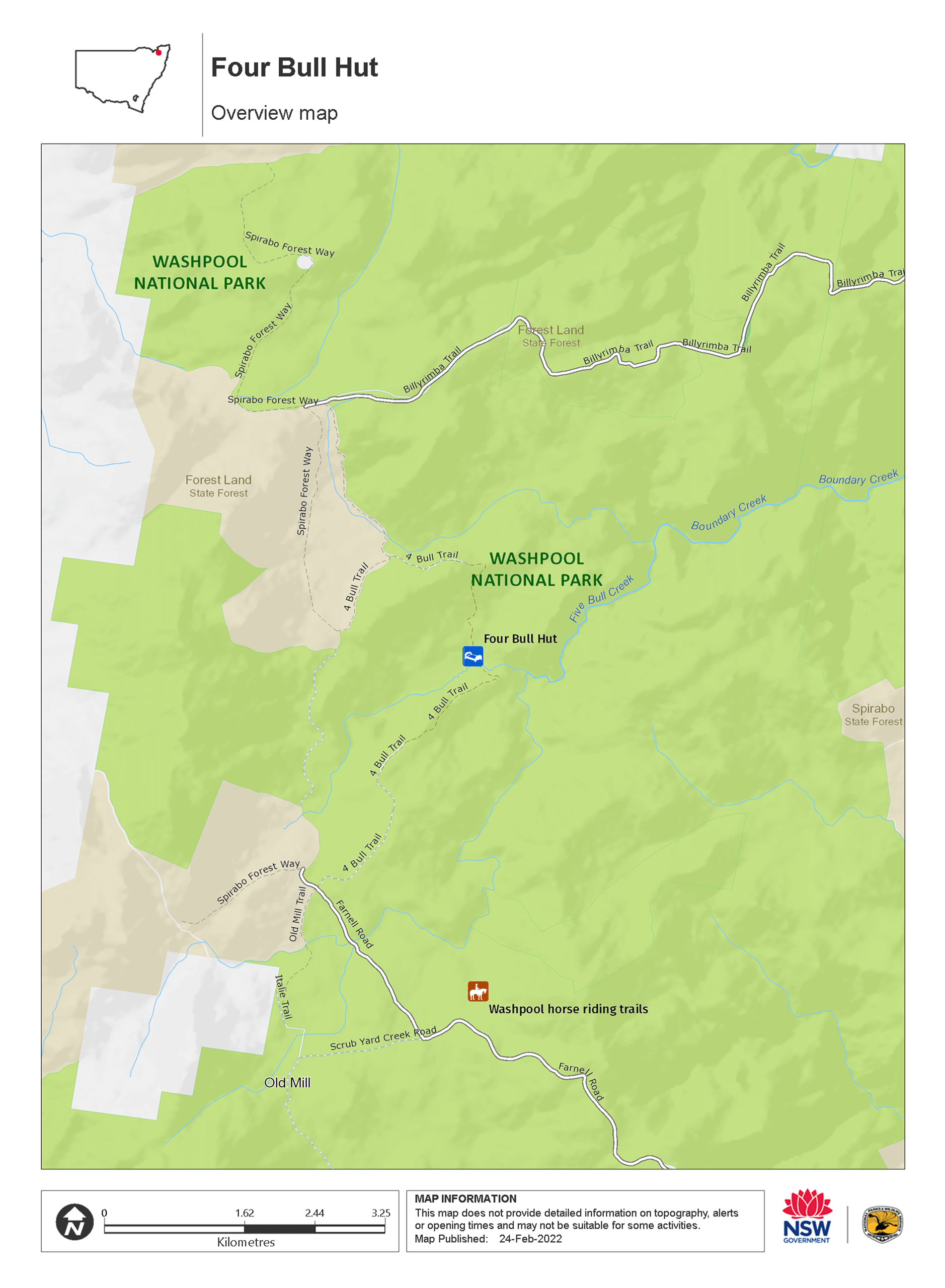
Map legend

Local alerts
For the latest updates on fires, closures and other alerts in this area, see https://www.nationalparks.nsw.gov.au/camping-and-accommodation/accommodation/four-bull-hut/local-alerts
Bookings
- National Parks Contact Centre
- 7am to 7pm daily
- 1300 072 757 (13000 PARKS) for the cost of a local call within Australia excluding mobiles
- parks.info@environment.nsw.gov.au
Operated by
- Glen Innes office
- Monday to Friday, 8.30am to 4.30pm.
- 02 6739 0700
- npws.ntab@environment.nsw.gov.au
- 68 Church Street, Glen Innes NSW 2370
Park info
- in Washpool National Park in the North Coast and Country NSW regions
Washpool National Park is always open but may have to close at times due to poor weather or fire danger.
-
Park entry fees:
$8 per vehicle per day applies only at attractions in the Glen Innes area. The park uses a self-registration fee collection system. Please bring the correct change and display your receipt.
Buy annual pass.
Visitor info
All the practical information you need to know about Four Bull Hut.
Getting there and parking
Four Bull Hut is located in the western section of Washpool National Park and is approximately 52km by road (sealed and gravel) from Tenterfield.
From Tenterfield:
- Travel south on the New England Highway for 28km
- Turn left on to Mt Spirabo Road and continue for 9km on the gravel road
- Turn right at the intersection with Sandy Flat Road and continue east on Mt Spirabo Road for 7km to the intersection with Spirabo Forest Way. There will be a sign when you enter Washpool National Park along the way.
- Keep left and continue through the intersection for 2.8km
- Turn right on to Farnell Road and travel for approximately 300m
- Turn left on to 4 Bull trail and continue 200m to the locked gate
- Unlock the gate using the PIN code provided with your booking confirmation, and follow the trail for around 4.3km to the hut
From Deepwater:
- Travel north on the New England Highway for 22km
- Turn right on to Mt Spirabo Road and continue for 9km on a gravel road
- Turn right at the intersection with Sandy Flat Road and continue east on Mt Spirabo Road for 7km to the intersection with Spirabo Forest Way. There will be a sign when you enter Washpool National Park along the way.
- Keep left and continue through the intersection for 2.8km
- Turn right on to Farnell Road and travel for approximately 300m
- Turn left on to 4 Bull trail and continue 200m to the locked gate
- Unlock the gate using the PIN code provided with your booking confirmation, and follow the trail for around 4.3km to the hut
PIN codes will be provided with your booking confirmation to access keys for the property. Contact 13000 72757 if you have not received your code. Fees may apply for lost keys.
Road quality
Vehicle access is restricted to existing management trails and no vehicles are permitted to be driven off-road within the National Park.
- Mixture of sealed and unsealed roads
Vehicle access
- All roads require 4WD vehicle
Weather restrictions
- Dry weather only
Parking
Outdoor parking is available at the hut.
Facilities
- The hut has 2 bedrooms. Bedding configuration: 1 bedroom with 1 double bed, 1 bedroom with 2 single beds and 2 single mattresses for the floor.
- Separate bathroom with shower, toilet and laundry sink.
- Dining room.
- The nearest mobile phone coverage is at the Billyrimba Falls lookout sign, which is 6.8km further north along Spirabo Forest Way from the Farnell Road turnoff.
- The horse yards are located around 200m from the accommodation. You'll need to provide feed and water.
- Please leave the property clean and tidy with all kitchen items washed up and put away. Additional fees may be charged for any unreasonable cleaning required or missing / broken items. Cleaning products and toilet paper are provided.
Toilets
- Flush toilets
Picnic tables
Barbecue facilities
- Fire rings (firewood supplied)
- Wood barbecues (firewood supplied)
Drinking water
Untreated water is available at the property but you'll need to treat or boil it before drinking.
Showers
- Hot showers
Electric power
Off-grid. A small 240V power generator is supplied. Please leave your personal electrical devices, including hairdryers and electric blankets, at home and use only the electrical devices provided in the hut.
Balcony
Covered verandah.
Outdoor furniture
Indoor fireplace
Indoor wood heater.
Kitchen
Gas stove and oven, gas hot water system and gas refrigerator, toaster, kettle and a kitchen table with seating for 4 people.
Plates and cutlery
Pots and pans
Rubbish bin
Please take any excessive garbage with you. Garbage bags are provided.
Maps and downloads
Accessibility
Four Bull Hut is not wheelchair-accessible.
Permitted
Chemical toilets are permitted however there is no dump point at the property.
Generators
Generators are permitted
Horses
A maximum of 6 horses are permitted at the property at any one time. Please read and comply with the code of practice for horse riding in parks.
Prohibited
- No hunting is permitted in Washpool National Park.
- It's an offence to pick and collect plants from national parks, including orchids and other threatened plant species, without an appropriate scientific licence.
Gathering firewood
- Firewood may not be collected from the park. Firewood is supplied.
Pets
Pets and domestic animals (other than certified assistance animals) are not permitted. Find out which regional parks allow dog walking and see the pets in parks policy for more information.
Smoking
NSW national parks are no smoking areas.
Learn more
Four Bull Hut is in Washpool National Park. Here are just some of the reasons why this park is special:
An important legacy
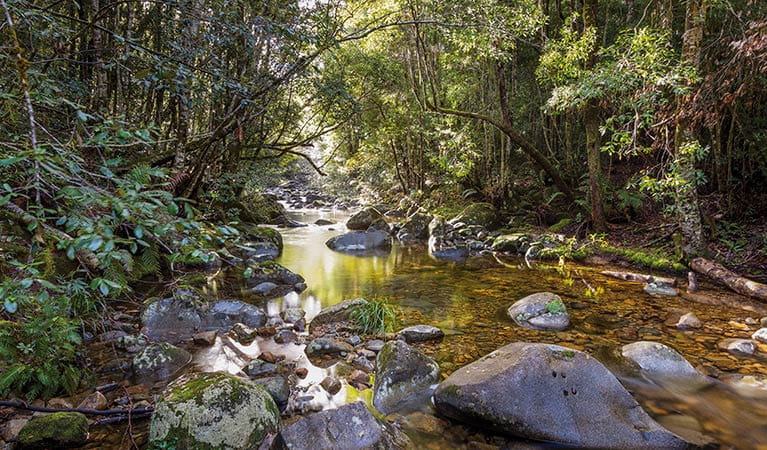
Washpool National Park is part of the Gondwana Rainforests of Australia World Heritage Area, which includes forty parks and reserves stretching along the Great Escarpment from Barrington Tops in NSW to south east Queensland. The area has a long history of selective logging, dating back to the 1800s when the valuable red cedar trees drew timber cutters with bullocks, axes and crosscut saws. With the development of machinery, the increasing pressure to exploit these forests met strong protest action from conservation groups. Ultimately, the park was created in 1983 after a study found the area contained significant plant and animal populations that either weren't found anywhere else in the state or were not well protected in reserves.
Cultural connections
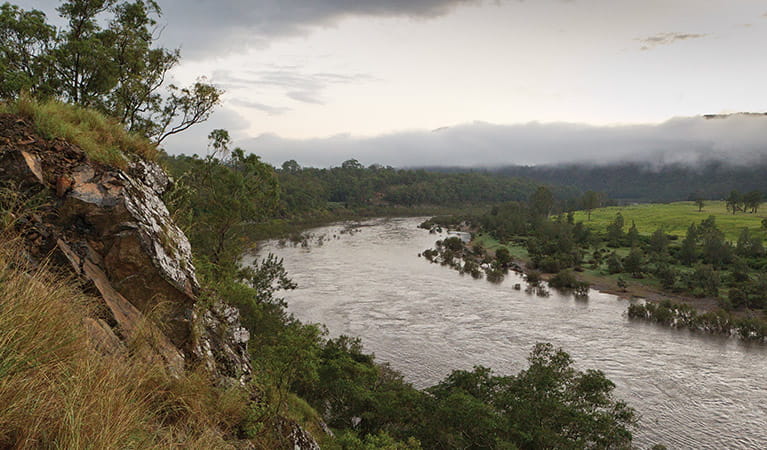
The Bundjalung, Ngarrabul and Gumbaingirri people have a long connection with the lands here; the area was once used as a route between the coast and the tablelands, and as a place to gather a range of resources, such as rainforest fruits.
Rare residents
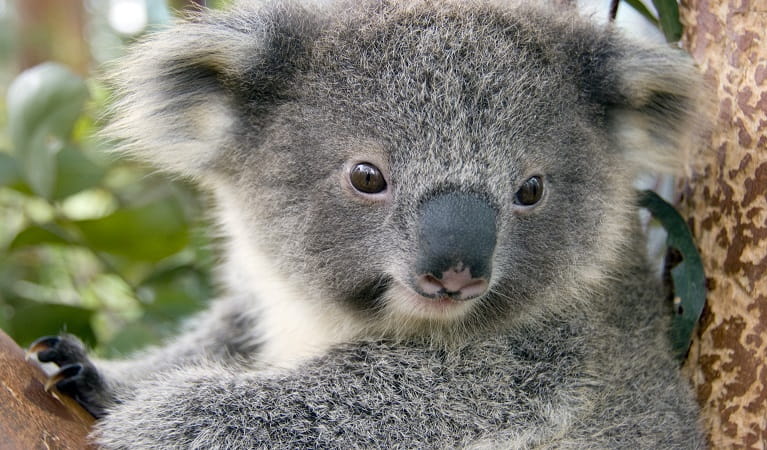
A huge range of threatened and endangered species enjoy the sanctuary of Washpool's diverse habitats. It's a refuge for mammals including koalas, spotted-tailed quolls, parma wallabies and long-nosed potoroos. Washpool and Gibraltar Range National Park are also brimming with birdlife. Look out for the rare rufous scrub bird in the rainforest undergrowth and, if you're extra vigilant, the even rarer powerful owl, which inhabits the hollows of trees in tall open forest. One of the most intriguing of the Washpool's residents is the pouched frog, a rainforest-dependent species whose male rears young tadpoles in pouches on his flanks.
- Coombadjha nature stroll Coombadjha nature stroll in Washpool National Park is a short yet inspiring walk through World Heritage listed rainforest, with a delightful swimming spot at the end.
- Washpool walking track Revel in the timeless wonder of ancient Gondwana Rainforest along Washpool walking track, and enjoy rare birdwatching and wildlife, in Washpool National Park, near Glen Innes.
Walker's wonderland
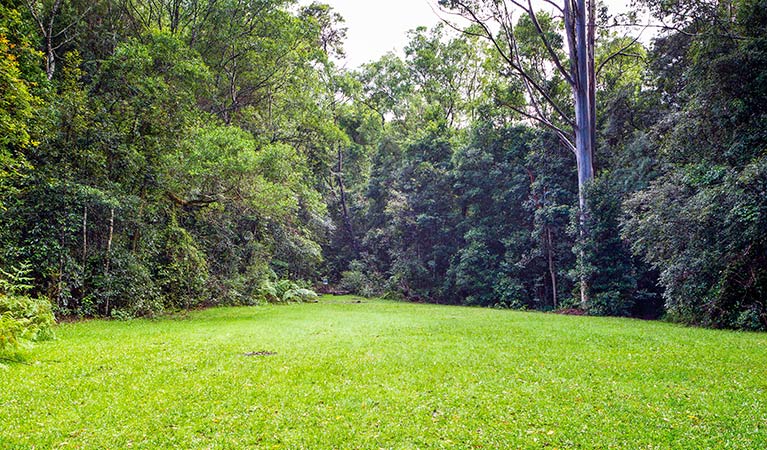
Lush rainforest, tinkling streams, dramatic gorges and an impressive plateau environment at just over the edge of the Great Escarpment make Washpool a singularly spectacular walking destination. Stretch your legs on an expansive network of graded walking tracks, including the popular World Heritage walk (which links Gibraltar Range and Washpool National Parks) and part of National trail. Nature strolls and the half-day Washpool walk commence from the creekside Coombadjha campground and take you on a meander through the lost world of the surrounding rainforest.
- Coachwood picnic area Enjoy a picnic surrounded by rainforest at Coachwood picnic area in Washpool National Park. It’s also the starting point for the Coombadjha nature stroll, a short walk.
- Granite picnic area Enjoy a picnic at Granite picnic area in Washpool National Park. Stretch your legs on an easy walk to Granite lookout for views over the World Heritage-listed landscape.
Plants and animals protected in this park
Animals
-

Swamp wallaby (Wallabia bicolor)
The swamp wallaby, also known as the black wallaby or black pademelon, lives in the dense understorey of rainforests, woodlands and dry sclerophyll forest along eastern Australia. This unique Australian macropod has a dark black-grey coat with a distinctive light-coloured cheek stripe.
-

Common ringtail possum (Pseudocheirus peregrinus)
Commonly found in forests, woodlands and leafy gardens across eastern NSW, the Australian ringtail possum is a tree-dwelling marsupial. With a powerful tail perfectly adapted to grasp objects, it forages in trees for eucalypt leaves, flowers and fruit.
-

Superb lyrebird (Menura novaehollandiae)
With a complex mimicking call and an elaborate courtship dance to match, the superb lyrebird is one of the most spectacular Australian animals. A bird watching must-see, the superb lyrebird can be found in rainforests and wet woodlands across eastern NSW and Victoria.
-

Southern boobook (Ninox novaeseelandiae)
The southern boobook, also known as the mopoke, is the smallest and most common native owl in Australia. With a musical 'boo-book' call that echoes through forests and woodlands, the southern boobook is a great one to look out for while bird watching.
Plants
-
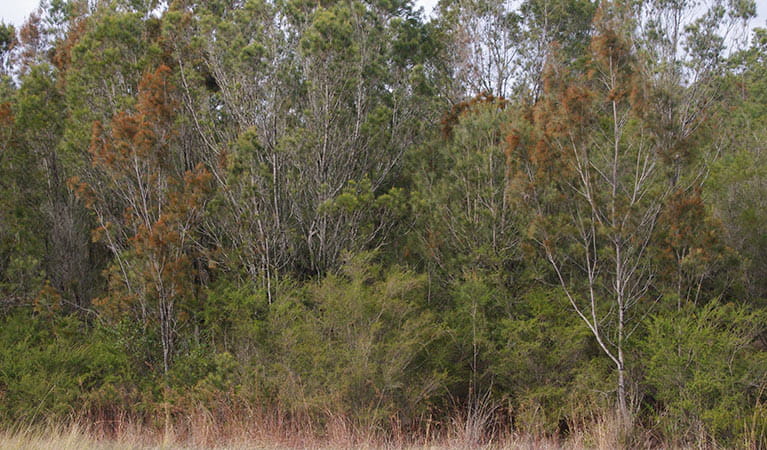
Black sheoak (Allocasuarina littoralis)
The black sheoak is one of a number of casuarina species found across the east coast of Australia and nearby tablelands. Growing to a height of 5-15m, these hardy Australian native plants can survive in poor or sandy soils. The barrel-shaped cone of the black sheoak grows to 10-30mm long.

